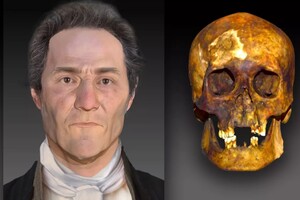DNA analysis showed that the man was indeed human.

Scientists recreated the appearance of a man who lived in 18th century in Griswold, Connecticut (USA). The man's femurs were found laid crosswise, indicating that the locals believed him to be a vampire. The DNA analysis conducted by the researchers helped restore his appearance and confirm that he was indeed human, Live Science reports.
The analysis of scientists showed that the man was about 55 years old at the time of his death and had tuberculosis. Scientists also found out that he had light skin, brown or light brown eyes, he was brunette or brown-haired with several freckles on his face.
Read also: Scientists recreated the appearance of a woman who lived 31 thousand years ago
Researchers analyzed the position of the man's legs and skull and concluded that his body was dug up after burial and reburied. Most often, this was done if they believed that a person was a vampire. According to scientists, in the past people often considered tuberculosis patients to be vampires.
“The remains were found with the femurs removed and placed crossed on the chest. That way, they wouldn't be able to walk around and attack the living,” said one Ellen Greatak, director of bioinformatics at Parabon NanoLabs and technical director of Snapshot Advanced DNA Analysis, which participated in the study.
To conduct analysis, scientists extracted DNA from the man's bones. They noted that this is quite a difficult task, since his remains are already over two hundred years old.
“As bones age, they eventually break and fragment. Also, when remains are in the environment for hundreds of years, bacteria and fungi get into the sample's DNA. We wanted to show that we can still extract DNA from complex historical samples,” Greytak stressed.
In traditional genome sequencing, researchers aim to sequence each part of the human genome 30 times, known as “30-fold coverage “. In the case of the decomposed male remains, sequencing gave only about 2.5-fold coverage. In addition, the researchers studied the remains of a man buried nearby. The comparison showed that the men were third-degree relatives or first cousins.
Related video
Archaeologists discovered the remains of a “vampire” in 1990. In 2019, researchers extracted DNA from the remains and ran it through an online genealogy database. It turned out that the “vampire” was actually a poor farmer named John Barber, who probably died of tuberculosis. The remains were identified as JB55, a “nickname” based on an epitaph written on the tombstone with copper nails, indicating his age and initials.




